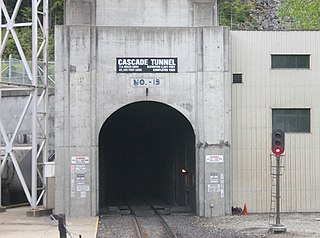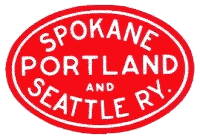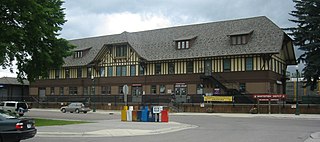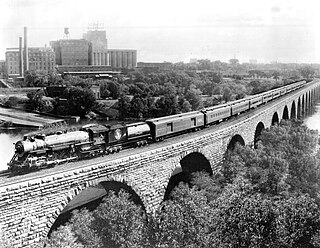
The Great Northern Railway was an American Class I railroad. Running from Saint Paul, Minnesota, to Seattle, Washington, it was the creation of 19th-century railroad entrepreneur James J. Hill and was developed from the Saint Paul & Pacific Railroad. The Great Northern's route was the northernmost transcontinental railroad route in the U.S.

The Burlington Northern Railroad was a United States-based railroad company formed from a merger of four major U.S. railroads. Burlington Northern operated between 1970 and 1996.

The Empire Builder is a daily long-distance passenger train operated by Amtrak between Chicago and either Seattle or Portland via two sections west of Spokane. Introduced in 1929, it was the flagship passenger train of the Great Northern Railway and was retained by Amtrak when it took over intercity rail service in 1971.

The Flathead Tunnel is a 7-mile-long (11 km) railroad tunnel in the Rocky Mountains of northwest Montana near Trego, approximately 28 miles (45 km) west of Whitefish. Located on the BNSF Railway's Kootenai River Subdivision, it is the second-longest railroad tunnel in the United States after the Cascade Tunnel. It is ultimately named after the Bitterroot Salish, also known as the Flathead.

The Cascade Tunnel refers to two railroad tunnels, its original tunnel and its replacement, in the northwest United States, east of the Seattle metropolitan area in the Cascade Range of Washington, at Stevens Pass. It is approximately 65 miles (105 km) east of Everett, with both portals adjacent to U.S. Route 2. Both single-track tunnels were constructed by the Great Northern Railway.

The Spokane, Portland & Seattle Railway was a railroad in the northwest United States. Incorporated in 1905, it was a joint venture by the Great Northern Railway and the Northern Pacific Railway to build a railroad along the north bank of the Columbia River. Remnants of the line are currently operated by BNSF Railway and the Portland and Western Railroad.

The North Coast Limited was a named passenger train operated by the Northern Pacific Railway between Chicago and Seattle via Bismarck, North Dakota. It started on April 29, 1900, and continued as a Burlington Northern Railroad train after the merger on March 2, 1970 with Great Northern Railway and the Chicago, Burlington and Quincy Railroad. The next year, it ceased operations after the trains which left their originating stations on April 30, 1971, the day before Amtrak began service, arrived at their destinations.

The North Coast Hiawatha was a streamlined passenger train operated by Amtrak between Chicago, Illinois, and Seattle, Washington. Operating from 1971 to 1979, the train was a successor to the Northern Pacific Railway's North Coast Limited and Mainstreeter. Its name is a combination of North Coast Limited and Hiawatha, a Chicago, Milwaukee, St. Paul and Pacific Railroad train whose route it followed east of Minneapolis–St. Paul. Created at the behest of the United States Congress, the North Coast Hiawatha enjoyed an uncertain existence before being discontinued in 1979. Since then, there have been several unsuccessful attempts to restore it.

Whitefish station is a stop on Amtrak's Empire Builder in Whitefish, Montana. In addition to the Empire Builder, a once-daily Greyhound Lines bus service also links the station to Kalispell and Missoula. A car rental agency operates a window within the station. The station and parking lot are owned by the Stumptown Historical Society. BNSF Railway leases office space on the upper floors of the station and owns the platform and track.

The Northern Transcon, a route operated by the BNSF Railway, traverses the most northerly route of any railroad in the western United States. This route was originally part of the Chicago, Burlington and Quincy Railroad, Northern Pacific Railway, Great Northern Railway and Spokane, Portland and Seattle Railway systems, merged into the Burlington Northern Railroad system in 1970.

The Western Star was a named passenger train operated by the Great Northern Railway between Chicago and the Pacific Northwest via Minneapolis/St. Paul, Minnesota. Between Chicago and St. Paul the train used the route of the Chicago, Burlington and Quincy Railroad; in later years eastbound passengers were accommodated on Burlington trains east of St. Paul. Through cars from the train operated between Spokane, Washington and Portland, Oregon via the Spokane, Portland and Seattle Railway. It operated from 1951 to 1971.

The Oriental Limited was a named passenger train that ran between Chicago, Illinois and Seattle, Washington. The train was operated by the Great Northern Railway between St. Paul, Minnesota and Seattle, Washington, and by the Chicago, Burlington and Quincy Railroad between St. Paul and Chicago. The train's name was intended to be evocative of travel to the Far East and Japan, since trans-Pacific Great Northern steamships once connected with the railway's trains in Seattle.

The Cascadian was anAmerican named train of the Great Northern Railway on its route between Seattle and Spokane, Washington. The service was short-lived, lasting five years between 1954 and 1959.

Great Northern Railway 1355 is a standard gauge steam railway locomotive built by Baldwin Locomotive Works in 1909 for the Great Northern Railway in the United States. It was built as a 4-6-0, Ten-Wheeler, type, but it had an extensive rebuild in 1924 when it became a 4-6-2, Pacific, type. During its career, it pulled both freight and passenger trains, including the Great Northern's crack Empire Builder and Oriental Limited.
The St. Paul Pass Tunnel was a railway tunnel in the northwest United States at St. Paul Pass, on the Montana-Idaho border. The tunnel was on the main line of the Chicago, Milwaukee, St. Paul & Pacific Railroad, commonly known as "The Milwaukee Road."

The Great Northern Z-1 was a class of ten electric locomotives built for the Great Northern Railway They were used to work the route through the second Cascade Tunnel. They were built between 1926–1928 by Baldwin Locomotive Works, with Westinghouse electrics, and stayed in service until dieselisation in 1956. Each was of 1,830 horsepower (1,360 kW) with a 1-D-1 wheel arrangement, although they were always used in coupled pairs.

Great Northern 2584 is a 4-8-4 "Northern" type steam locomotive built by the Baldwin Locomotive Works in Philadelphia, Pennsylvania in March 1930 for the Great Northern Railway (GN) as a member of the S-2 class.

The Great Northern S-2 was a class of 14 4-8-4 "Northern" type steam locomotives built by the Baldwin Locomotive Works in 1930 and operated by the Great Northern Railway until the late 1950s.

The Great Northern P-2 was a class of 28 4-8-2 "Mountain" type steam locomotives built by the Baldwin Locomotive Works in 1923 and operated by the Great Northern Railway until the late 1950s.

Great Northern 2507 is a 4-8-2 "Mountain" type steam locomotive, a member of the P-2 class. Built for passenger service, the locomotive was assigned to pull the Great Northern's mainline passenger trains such as the Empire Builder and Oriental Limited, until being retired in December 1957 and sold to Spokane, Portland and Seattle Railway. GN 2507 is one of only two surviving examples of a P-2 class locomotive and, since 2003, has been on display at Wishram station in Wishram, Washington.



















